A Literature Review on Strategic, Tactical, and Operational Perspectives in EV Charging Station Planning and Scheduling
Abstract
1. Introduction
2. Background
2.1. Charging Levels
- Level 1 Charging: Level 1 is the slowest and simplest charging method, utilizing a standard 120 volt household outlet. It is typically used for overnight charging at home. The charging rate for Level 1 is around 2 to 5 miles of range per hour.
- Level 2 Charging: Level 2 chargers operate at 240 volts and are commonly found in residential garages, workplaces, and public charging stations. They offer much faster charging than Level 1, providing approximately 10 to 30 miles of range per hour of charging.
- Level 3 Charging (DC Fast Charging): Also known as rapid charging or DC fast charging, Level 3 chargers use high-voltage Direct Current (DC) to charge vehicles significantly faster than Levels 1 and 2. These chargers are often located along highways and major routes, allowing EVs to gain up to 100 miles of range in just 20–30 min.
2.2. Charging Connectors
- Level 1 and Level 2 Connectors: The SAE J1772 EV plug is the most common connector used for Level 1 and Level 2 charging in North America. It is a standardized interface that ensures compatibility between EVs and charging stations. While Tesla vehicles use their own proprietary connector for Tesla Supercharger stations, they also come with an adapter to charge using the SAE J1772 plug, ensuring compatibility with other charging stations. SAE J1772 connectors are primarily for Level 1 and Level 2 charging, which are suited for slower, overnight charging.
- Level 3 Connectors: For rapid DC fast charging (Level 3), the most common connectors are CHAdeMO and the SAE Combo (also known as CCS or Combo Charging System). These two connectors are not interchangeable, meaning that a vehicle with a CHAdeMO port cannot use an SAE Combo plug, and vice versa. Tesla also has its own exclusive connector for its Supercharger stations, which is only compatible with Tesla vehicles. Although SAE J1772 specifies six charging levels, only three are widely used in North America: Level 1 (120 VAC), Level 2 (208–240 VAC), and fast charging (200–450 VDC). Tesla’s proprietary Supercharger network is another DC fast-charging system used exclusively for Tesla vehicles [29].
2.3. Wireless Charging of Electric Vehicles
- AC to DC Conversion: AC power is first converted into DC power using an AC to DC converter.
- Power Transmission: The DC power is then converted into a high-frequency signal, which drives the transmission signal through a compensating network.
- Safety Features: A high-frequency isolation transformer is used to protect the system by preventing insulation failure.
- Magnetic Field Induction: The transmitter coil generates an alternating magnetic field, which induces an AC voltage in the receiver coil.
- Wireless power transmission systems consist of components like rectifiers, power factor correctors, inverters, network compensators, and magnetic couplers (transmitter and receiver coils).
3. Data Collection
4. Charging Station Deployment and Placement
4.1. Location Planning for EV Charging Stations
4.2. Optimization Models and Techniques
- Mathematical models,
- Simulation models, and
- Meta-heuristic algorithms.
4.3. Urban Traffic and Demand Considerations
4.3.1. EV Charging Station Location Models
4.3.2. Location Based on Traffic Flow
4.3.3. Routing Considerations
4.4. GIS and Advanced Tools for Planning
4.5. Combination of Charging Strategies (Slow and Fast)
5. Optimal Allocation and Scheduling of EV Parking Lots
- Scheduling and optimization of EV charging and discharging,
- Intelligent parking lot management,
- Advanced techniques and cooperative mechanisms.
5.1. Scheduling and Optimization of EV Charging and Discharging
5.2. Intelligent Parking Lot Management
5.3. Advanced Techniques and Cooperative Mechanisms
5.4. Emerging AI Techniques for Demand Forecasting
6. V2G and Smart Charging Systems
6.1. Planning and Siting of EV Parking Lots
6.2. Integration with Distributed Energy Resources and Renewables
6.3. Challenges and Implementation of V2G Systems
6.4. Scheduling and Charging Management
6.5. Advanced Optimization Models and Frameworks
6.6. Multi-Objective and Economic Allocation for Parking Lots
6.7. Scheduling and Charging Management
7. Conclusions, Limitations, and Future Research Directions
- Charging station deployment and placement,
- Optimal allocation and scheduling of EV parking lots,
- V2G (Vehicle-to-Grid) and smart charging systems.
- Climate and Geographic Adaptability: Investigate how EV and V2G systems perform under diverse climatic conditions and urban forms, especially in developing countries where infrastructure and energy access vary significantly.
- Dynamic Pricing and User Behavior: Explore how real-time and time-of-use pricing models influence user participation in smart charging and V2G programs and develop adaptive scheduling algorithms that respond to these incentives.
- Best Practices and Policy Frameworks: Conduct comparative studies across regions to identify effective regulatory, financial, and technical strategies for EV infrastructure deployment, with a focus on scalability and equity.
- Sustainability and Grid Integration: Assess the environmental and economic impacts of integrating renewable energy sources (e.g., solar, wind) into EV charging networks, including lifecycle emissions and grid stability.
- AI-Driven Predictive Scheduling: Develop machine learning models that forecast demand, user behavior, and renewable generation to optimize real-time charging and discharging schedules, particularly in high-penetration EV scenarios.
Author Contributions
Funding
Data Availability Statement
Conflicts of Interest
Abbreviations
| ABM | Agent-Based Model |
| AHP | Analytic Hierarchy Process |
| APSO | Adaptive Particle Swarm Optimization |
| CMCLP | Capacitated Maximal Coverage Location Problem |
| DE | Differential Evolution |
| FILP | Fuzzy Integer Linear Programming |
| FISA | Fuzzy Inference System-Based Algorithm |
| GA | Genetic Algorithm |
| GPSR | Greedy Perimeter Stateless Routing |
| GWO | Grey Wolf Optimizer |
| HGA | Hybrid Genetic Algorithm |
| HMA | Hybrid Meta-heuristic Algorithm |
| IP | Integer Programming |
| LP | Linear Programming |
| MAS | Multi-Agent Based Simulation |
| MCLP | Maximum Covering Location Problem |
| MILP | Mixed-Integer Linear Programming |
| MINLP | Mixed-Integer Non-linear Programming |
| MOHESA | Multi-Objective Heuristic EV Scheduling Algorithm |
| MOOP | Multi-Objective Optimization Problem |
| MIP | Mixed-Integer Programming |
| PSO | Particle Swarm Optimization |
| RES | Renewable Energy Sources |
| SCLP | Set Covering Location Problem |
| SoC | State of Charge |
| SVR | Support Vector Regression |
| V2G | Vehicle-to-Grid |
| WOA | Whale Optimization Algorithm |
References
- Wang, Y.W.; Lin, C.C. Locating multiple types of recharging stations for battery-powered electric vehicle transport. Transp. Res. Part E Logist. Transp. Rev. 2013, 58, 76–87. [Google Scholar] [CrossRef]
- Chan, C.C. The state of the art of electric, hybrid, and fuel cell vehicles. Proc. IEEE 2007, 95, 704–718. [Google Scholar] [CrossRef]
- Mom, G. The Electric Vehicle: Technology and Expectations in the Automobile Age; Johns Hopkins University Press: Baltimore, MD, USA, 2013. [Google Scholar]
- Hardman, S.; Jenn, A.; Tal, G.; Axsen, J.; Beard, G.; Daina, N.; Witkamp, B. A review of consumer preferences of and interactions with electric vehicle charging infrastructure. Transp. Res. Part D Transp. Environ. 2018, 62, 508–523. [Google Scholar] [CrossRef]
- International Energy Agency (IEA). Global EV Outlook 2023: Catching up with Climate Ambitions. 2023. Available online: https://www.iea.org/reports/global-ev-outlook-2023 (accessed on 4 July 2025).
- Olabi, A.G.; Abdelkareem, M.A. Renewable energy and climate change. Renew. Sustain. Energy Rev. 2022, 158, 112111. [Google Scholar] [CrossRef]
- Li, W.; Ji, J.; Dong, H.; Sun, G.; He, M. Study on the control strategy of VSG-based hydrogen production unit grid-connected for weak grid. Energy Rep. 2023, 9, 3695–3702. [Google Scholar] [CrossRef]
- Ademulegun, O.O.; MacArtain, P.; Oni, B.; Hewitt, N.J. Multi-stage multi-criteria decision analysis for siting electric vehicle charging stations within and across border regions. Energies 2022, 24, 9396. [Google Scholar] [CrossRef]
- Bekel, K.; Pauliuk, S. Prospective cost and environmental impact assessment of battery and fuel cell electric vehicles in Germany. Int. J. Life Cycle Assess. 2019, 24, 2220–2237. [Google Scholar] [CrossRef]
- International Energy Agency. Global EV Outlook 2024: Trends and Developments in Electric Vehicle Markets. 2024. Available online: https://www.iea.org/reports/global-ev-outlook-2024 (accessed on 4 July 2025).
- BloombergNEF. Electric Vehicle Outlook 2025. 2025. Available online: https://about.bnef.com/electric-vehicle-outlook/ (accessed on 4 July 2025).
- Jain, S.; Jain, S.; Kumar, S.; Kaushik, H.; Nagpal, N.; Sharma, R. Design and development of a solar-Based wireless electric charging system. In Renewable Power for Sustainable Growth; Springer: Singapore, 2024; pp. 481–494. [Google Scholar]
- International Energy Agency (IEA). Global EV Outlook 2021. 2021. Available online: https://www.iea.org/reports/global-ev-outlook-2021 (accessed on 4 July 2025).
- Bank, W. Electric Vehicles: An Economic and Environmental Win for Developing Countries. 2022. Available online: https://www.worldbank.org/en/news/feature/2022/11/17/electric-vehicles-an-economic-and-environmental-win-for-developing-countries (accessed on 3 July 2025).
- Berman, O.; Larson, R.C.; Fouska, N. Optimal location of discretionary service facilities. Transp. Sci. 1992, 26, 201–211. [Google Scholar] [CrossRef]
- Biswas, S.; Behera, S.; Mekapati, S.R.; Choudhury, N.D. Rapid EV market expansion due to V2G technology: A review on V2G grid load balancing and control. In Proceedings of the International Conference on Sustainable Technology and Advanced Computing in Electrical Engineering; Springer: Singapore, 2023; pp. 381–405. [Google Scholar]
- Kuby, M.; Lim, S. The flow-refueling location problem for alternative-fuel vehicles. Socio-Econ. Plan. Sci. 2005, 39, 125–145. [Google Scholar] [CrossRef]
- Lachhab, N. Robust Controller Optimization: Application to a Parallel Hybrid Electric Vehicle (PHEV). Ph.D. Thesis, University of the Federal Armed Forces Munich, Neubiberg, Germany, 2016. [Google Scholar]
- Wong, J.H.; Sutikno, T.; Idris, N.R.N.; Anwari, M. A Parallel Energy-Sharing control Strategy for Fuel Cell Hybrid Vehicle. TELKOMNIKA Telecommun. Comput. Electron. Control 2021, 9, 357–364. [Google Scholar] [CrossRef][Green Version]
- IEEE Spectrum. EV Battery Swapping Is Back, and This Time It Might Work. 2023. Available online: https://spectrum.ieee.org/ev-battery-2658649740 (accessed on 4 July 2025).
- Jin, C.; Tang, J.; Ghosh, P. Optimizing electric vehicle charging with energy storage in the electricity market. IEEE Trans. Smart Grid 2013, 4, 311–320. [Google Scholar] [CrossRef]
- Brenna, M.; Foiadelli, F.; Leone, C.; Longo, M. Electric vehicles charging technology review and optimal size estimation. J. Electr. Eng. Technol. 2020, 15, 2539–2552. [Google Scholar] [CrossRef]
- Enang, W. Robust Real-Time Control of a Parallel Hybrid Electric Vehicle. Ph.D. Thesis, University of Bath, Bath, UK, 2016. [Google Scholar]
- Power Sonic. Levels of EV Charging. Power Sonic Blog. Available online: https://www.power-sonic.com/blog/levels-of-ev-charging/ (accessed on 17 December 2024).
- Shahnia, F.; Ghosh, A.; Ledwich, G.; Zare, F. Voltage unbalance sensitivity analysis of plug-in electric vehicles in distribution networks. In Proceedings of the IEEE AUPEC 2011, Brisbane, QLD, Australia, 25–28 September 2011; pp. 1–6. [Google Scholar]
- Veneri, O.; Capasso, C.; Ferraro, L.; Del Pizzo, A. Performance analysis on a power architecture for EV ultra-fast charging stations. In Proceedings of the 2013 IEEE International Conference on Clean Electrical Power (ICCEP), Alghero, Italy, 11–13 June 2013; pp. 183–188. [Google Scholar]
- Villa, J.L.; Sallan, J.; Osorio, J.F.S.; Llombart, A. High-misalignment tolerant compensation topology for ICPT systems. IEEE Trans. Ind. Electron. 2011, 59, 945–951. [Google Scholar] [CrossRef]
- Wang, C.S.; Covic, G.A.; Stielau, O.H. Power transfer capability and bifurcation phenomena of loosely coupled inductive power transfer systems. IEEE Trans. Ind. Electron. 2004, 51, 148–157. [Google Scholar] [CrossRef]
- Apata, O.; Bokoro, P.N.; Sharma, G. The risks and challenges of electric vehicle integration into smart cities. Energies 2023, 16, 5274. [Google Scholar] [CrossRef]
- Nath, S. Vehicle-to-vehicle wireless charging with decoupled primary side control. Electr. Eng. 2024, 106, 7343–7352. [Google Scholar] [CrossRef]
- Li, S.; Li, W.; Deng, J.; Nguyen, T.D.; Mi, C.C. A double-sided LCC compensation network and its tuning method for wireless power transfer. IEEE Trans. Veh. Technol. 2015, 64, 2261. [Google Scholar] [CrossRef]
- Lu, F.; Zhang, H.; Hofmann, H.; Mi, C. An inductive and capacitive integrated coupler and its LCL compensation circuit design for wireless power transfer. In Proceedings of the IEEE Energy Conversion Congress and Exposition (ECCE), Milwaukee, WI, USA, 18–22 September 2016. [Google Scholar] [CrossRef]
- Iravani, H. A multicriteria GIS-based decision-making approach for locating electric vehicle charging stations. Transp. Eng. 2022, 9, 100135. [Google Scholar] [CrossRef]
- Rahmani-Andebili, M. Optimal placement and sizing of parking lots for the plug-in electric vehicles considering the technical, social, and geographical aspects. In Planning and Operation of Plug-In Electric Vehicles: Technical, Geographical, and Social Aspects; Springer: Cham, Switzerland, 2019; pp. 149–209. [Google Scholar]
- Zhang, R.; Cheng, X.; Yang, L. Stable matching based cooperative V2V charging mechanism for electric vehicles. In Proceedings of the 2017 IEEE 86th Vehicular Technology Conference (VTC-Fall), Toronto, ON, Canada, 24–27 September 2017; pp. 1–5. [Google Scholar]
- Kempton, W.; Tomic, J. Vehicle-to-grid power fundamentals: Calculating capacity and net revenue. J. Power Sources 2005, 144, 268–279. [Google Scholar] [CrossRef]
- Çelik, S.; Ok, Ş. Electric vehicle charging stations: Model, algorithm, simulation, location, and capacity planning. Heliyon 2024, 10, e29153. [Google Scholar] [CrossRef]
- Lazari, V.; Chassiakos, A. Multi-objective optimization of electric vehicle charging station deployment using genetic algorithms. Appl. Sci. 2023, 13, 4867. [Google Scholar] [CrossRef]
- Aparna, N.; Aruldevi, G.; Oviya, S.A. Comparison of GA and PSO Optimization Techniques to Optimal Planning of Electric Vehicle Charging Station at our Local Distribution System. Int. Res. J. Eng. Technol. (IRJET) 2020, 7, 2579–2581. [Google Scholar]
- Chawal, U.; Rosenberger, J.M.; Chen, V.C.; Lee, W.J.; Punugu, R.K.; Wijemanne, M.; Kulvanitchaiyanunt, A. Optimizing a System of Electric Vehicle Charging Stations Using Mixed Integer Linear Programming Computer Experiments. 2018. Available online: https://ssrn.com/abstract=4572175 (accessed on 17 December 2024).
- Hu, T.; Liwang, M.; Huang, L.; Tang, Y. An enhanced GPSR routing protocol based on the buffer length of nodes for the congestion problem in VANETs. In Proceedings of the 10th IEEE International Conference on Computer Science and Education (ICCSE), Cambridge, UK, 22–24 July 2015; pp. 416–419. [Google Scholar]
- Hussain, S.; Kim, Y.S.; Thakur, S.; Breslin, J.G. Optimization of waiting time for electric vehicles using a fuzzy inference system. IEEE Trans. Intell. Transp. Syst. 2022, 23, 15396–15407. [Google Scholar] [CrossRef]
- Yang, W. A location problem of fast charging stations considering congestion. J. Int. Logist. Trade 2017, 15, 91–101. [Google Scholar] [CrossRef]
- Ko, Y.B.; Vaidya, N.H. Location-aided routing (LAR) in mobile ad hoc networks. In Proceedings of the 4th Annual ACM/IEEE International Conference on Mobile Computing and Networking, Dallas, TX, USA, 25–30 October 1998; pp. 66–75. [Google Scholar]
- Janjić, A.; Velimirović, L.; Velimirović, J.; Vranić, P. Estimating the optimal number and locations of electric vehicle charging stations: The application of multi-criteria p-median methodology. Transp. Plan. Technol. 2021, 44, 827–842. [Google Scholar] [CrossRef]
- Mortaz, E.; Vinel, A.; Dvorkin, Y. An optimization model for siting and sizing of vehicle-to-grid facilities in a microgrid. Appl. Energy 2019, 242, 1649–1660. [Google Scholar] [CrossRef]
- Lam, A.Y.S.; Leung, Y.W.; Chu, X. Electric vehicle charging station placement: Formulation, complexity, and solutions. IEEE Trans. Smart Grid 2014, 5, 2846–2856. [Google Scholar] [CrossRef]
- Elnozahy, M.S.; Salama, M.M. A comprehensive study of the impacts of PHEVs on residential distribution networks. IEEE Trans. Sustain. Energy 2013, 5, 332–342. [Google Scholar] [CrossRef]
- Wang, Z.; Paranjape, R. An evaluation of electric vehicle penetration under demand response in a multi-agent-based simulation. In Proceedings of the 2014 IEEE Electrical Power and Energy Conference (EPEC), Calgary, AB, Canada, 12–14 November 2014; pp. 220–225. [Google Scholar]
- Xi, X.; Sioshansi, R.; Marano, V. Simulation–optimization model for location of a public electric vehicle charging infrastructure. Transp. Res. Part D Transp. Environ. 2013, 22, 60–69. [Google Scholar] [CrossRef]
- Yi, Z.; Chen, B.; Liu, X.; Wei, R.; Chen, J.; Chen, Z. An agent-based modeling approach for public charging demand estimation and charging station location optimization at urban scale. Comput. Environ. Urban Syst. 2023, 101, 101949. [Google Scholar] [CrossRef]
- Liu, Z.; Zhang, W.; Ji, X.; Li, K. Optimal Planning of charging station for electric vehicle based on particle swarm optimization. In Proceedings of the IEEE PES Innovative Smart Grid Technologies, Tianjin, China, 21–24 May 2012; pp. 1–5. [Google Scholar]
- You, P.S.; Hsieh, Y.C. A hybrid heuristic approach to the problem of the location of vehicle charging stations. Comput. Ind. Eng. 2015, 70, 195–204. [Google Scholar] [CrossRef]
- Konstantinidis, G.; Kanellos, F.D.; Kalaitzakis, K. A simple multi-parameter method for efficient charging scheduling of electric vehicles. Appl. Syst. Innov. 2021, 4, 58. [Google Scholar] [CrossRef]
- Rajabi-Ghahnavieh, A.; Sadeghi-Barzani, P. Optimal zonal fast-charging station placement considering urban traffic circulation. IEEE Trans. Veh. Technol. 2017, 66, 45–56. [Google Scholar] [CrossRef]
- Pazouki, S.; Mohsenzadeh, A.; Ardalan, S.; Haghifam, M.R. Simultaneous planning of PEV charging stations and DGs considering financial, technical, and environmental effects. Can. J. Electr. Comput. Eng. 2023, 38, 238–245. [Google Scholar] [CrossRef]
- Zhang, X.; Bai, X.; Shang, J. Is subsidized electric vehicles adoption sustainable: Consumers’ perceptions and motivation toward incentive policies, environmental benefits, and risks. J. Clean. Prod. 2018, 192, 71–79. [Google Scholar] [CrossRef]
- Chandra, M.; Vansola, B.; Shukla, R. Set cover model-based optimum location of electric vehicle charging stations. Curr. Sci. 2022, 123, 1448. [Google Scholar] [CrossRef]
- Ge, S.; Feng, L.; Liu, H. The planning of electric vehicle charging station based on grid partition method. In Proceedings of the 2023 IEEE International Conference on Electrical and Control Engineering, Yichang, China, 16–18 September 2023; pp. 2726–2730. [Google Scholar]
- He, J.; Yang, H.; Tang, T.Q.; Huang, H.J. An optimal charging station location model with the consideration of electric vehicle’s driving range. Transp. Res. Part C Emerg. Technol. 2018, 86, 641–654. [Google Scholar] [CrossRef]
- Li, Y.; Pei, W.; Zhang, Q.; Xu, D.; Ma, H. Optimal layout of electric vehicle charging station locations considering dynamic charging demand. Electronics 2023, 12, 1818. [Google Scholar] [CrossRef]
- Zeng, X.; Xie, C.; Xu, M.; Chen, Z. Optimal en-route charging station locations for electric vehicles with heterogeneous range anxiety. Transp. Res. Part C Emerg. Technol. 2024, 158, 104459. [Google Scholar] [CrossRef]
- Campana, M.; Inga, E. Optimal deployment of fast-charging stations for electric vehicles considering the sizing of the electrical distribution network and traffic condition. Energy Rep. 2023, 9, 5246–5268. [Google Scholar] [CrossRef]
- Davidov, S.; Pantos, M. Planning of electric vehicle infrastructure based on charging reliability and quality of service. Energy 2017, 118, 1156–1167. [Google Scholar] [CrossRef]
- Gan, X.; Zhang, H.; Hang, G.; Qin, Z.; Jin, H. Fast-charging station deployment considering elastic demand. IEEE Trans. Transp. Electrif. 2020, 6, 158–169. [Google Scholar] [CrossRef]
- Zafar, U.; Bayram, I.S.; Bayhan, S. A GIS-based optimal facility location framework for fast electric vehicle charging stations. In Proceedings of the 2021 IEEE 30th International Symposium on Industrial Electronics (ISIE), Kyoto, Japan, 20–23 June 2021; pp. 1–5. [Google Scholar]
- Jia, L.; Hu, Z.; Liang, W.; Lang, W.; Song, Y. A novel approach for urban electric vehicle charging facility planning considering combination of slow and fast charging. In Proceedings of the 2014 IEEE International Conference on Power System Technology (POWERCON), Chengdu, China, 20–22 October 2014; pp. 3354–3360. [Google Scholar]
- Xu, M.; Gao, S.; Zheng, J.; Huang, X.; Wu, C. Day-ahead electric vehicle charging behavior forecasting and schedulable capacity calculation for electric vehicle parking lot. Energy 2024, 309, 133090. [Google Scholar] [CrossRef]
- Yan, X.; Duan, C.; Chen, X.; Duan, Z. Planning of Electric Vehicle charging station based on hierarchic genetic algorithm. In Proceedings of the 2014 IEEE Conference and Expo Transportation Electrification Asia-Pacific (ITEC Asia-Pacific), Beijing, China, 31 August–3 September 2014; pp. 1–5. [Google Scholar]
- Hu, Z.; Song, Y. Distribution network expansion planning with optimal siting and sizing of electric vehicle charging stations. In Proceedings of the 47th International Universities Power Engineering Conference (UPEC), Uxbridge, Middlesex, UK, 4–7 September 2012; pp. 1–6. [Google Scholar]
- Rastegarfar, N.; Kashanizadeh, B.; Vakilian, M.; Barband, S.A. Optimal placement of fast charging station in a typical microgrid in Iran. In Proceedings of the 2013 10th International IEEE Conference on the European Energy Market (EEM), Stockholm, Sweden, 27–31 May 2013; pp. 1–7. [Google Scholar]
- Xu, G.; Liu, Y.; Hu, X.; Xiong, X.; Wang, Q.; Zhou, N. Study on the proportional allocation of electric vehicles with conventional and fast charge methods when in distribution network. In Proceedings of the 2012 China International Conference on Electricity Distribution, Shanghai, China, 10–14 September 2012; pp. 1–5. [Google Scholar]
- Shaheen, H.I.; Rashed, G.I.; Yang, B.; Yang, J. Optimal electric vehicle charging and discharging scheduling using metaheuristic algorithms: V2G approach for cost reduction and grid support. J. Energy Storage 2024, 90, 111816. [Google Scholar] [CrossRef]
- Rezaei, P.; Akhbari, M. Optimal management of EV parking-lot charging/discharging for load profile peak shaving and valley filling in microgrids [Preprint]. SSRN 2023. [Google Scholar] [CrossRef]
- Rezaei, P.; Golkar, M.A. Economic Load Curve Flattening by EVs Charge and Discharge Scheduling in the Smart Grid Considering Machine Learning-based Forecasted Load. In Proceedings of the 2021 11th IEEE Smart Grid Conference (SGC), Tabriz, Iran, 7–9 December 2021; pp. 1–5. [Google Scholar]
- Sharma, A.; Shih, S.; Srinivasan, D. A smart scheduling strategy for charging and discharging of electric vehicles. In Proceedings of the 2015 IEEE Innovative Smart Grid Technologies-Asia (ISGT ASIA), Bangkok, Thailand, 3–6 November 2015; pp. 1–6. [Google Scholar]
- Ahmadi, M.; Hosseini, S.H.; Farsadi, M. Optimal allocation of electric vehicles parking lots and optimal charging and discharging scheduling using hybrid metaheuristic algorithms. J. Electr. Eng. Technol. 2021, 16, 759–770. [Google Scholar] [CrossRef]
- Shariatzadeh, M.; Antunes, C.H.; Lopes, M.A. Charging scheduling in a workplace parking lot: Bi-objective optimization approaches through predictive analytics of electric vehicle users’ charging behavior. Sustain. Energy Grids Netw. 2024, 39, 101463. [Google Scholar] [CrossRef]
- Tostado-Véliz, M.; Jordehi, A.R.; Mansouri, S.A.; Jurado, F. A two-stage IGDT-stochastic model for optimal scheduling of energy communities with intelligent parking lots. Energy 2023, 263, 126018. [Google Scholar] [CrossRef]
- Yang, Z.; Huang, X.; Gao, T.; Liu, Y.; Gao, S. Real-time energy management strategy for parking lot considering maximum penetration of electric vehicles. IEEE Access 2022, 10, 5281–5291. [Google Scholar] [CrossRef]
- Sausen, J.P.; Abaide, A.R.; Vasquez, J.C.; Guerrero, J.M. Battery-Conscious, Economic, and Prioritization-Based Electric Vehicle Residential Scheduling. Energies 2022, 15, 3714. [Google Scholar] [CrossRef]
- Mirzaei, M.J.; Kazemi, A.; Homaee, O. A probabilistic approach to determine optimal capacity and location of electric vehicles parking lots in distribution networks. IEEE Trans. Ind. Inform. 2015, 12, 1963–1972. [Google Scholar] [CrossRef]
- Alinejad, M.; Rezaei, O.; Kazemi, A.; Bagheri, S. An optimal management for charging and discharging of electric vehicles in an intelligent parking lot considering vehicle owner’s random behaviors. J. Energy Storage 2021, 35, 102245. [Google Scholar] [CrossRef]
- Honarmand, M.; Zakariazadeh, A.; Jadid, S. Self-scheduling of electric vehicles in an intelligent parking lot using stochastic optimization. J. Frankl. Inst. 2015, 352, 449–467. [Google Scholar] [CrossRef]
- Nejati, S.A.; Chong, B.; Alinejad, M.; Abbasi, S. Optimal scheduling of electric vehicles charging and discharging in a smart parking-lot. In Proceedings of the 2021 56th IEEE International Universities Power Engineering Conference (UPEC), Middlesbrough, UK, 31 August–3 September 2021; pp. 1–6. [Google Scholar]
- Zenhom, I.A.; Shaaban, M.F.; Omran, W.A. Grid interactive charging of EVs in PV-powered parking lots considering uncertainties. IEEE Access 2023, 11, 111292–111301. [Google Scholar] [CrossRef]
- Mehrabi, A.; Kim, K. Low-complexity charging/discharging scheduling for electric vehicles at home and common lots for smart households prosumers. IEEE Trans. Consum. Electron. 2018, 64, 348–355. [Google Scholar] [CrossRef]
- Manshadi, S.D.; Khodayar, M.E.; Abdelghany, K.; Üster, H. Wireless charging of electric vehicles in electricity and transportation networks. IEEE Trans. Smart Grid 2017, 9, 4503–4512. [Google Scholar] [CrossRef]
- Baharifard, M.A.; Kazemzadeh, R.; Yazdankhah, A.S.; Marzband, M. Intelligent charging planning for electric vehicle commercial parking lots and its impact on distribution network’s imbalance indices. Sustain. Energy Grids Netw. 2022, 30, 100620. [Google Scholar] [CrossRef]
- Sadati, S.M.B.; Rastgou, A.; Shafie-khah, M.; Bahramara, S.; Hosseini-hemati, S. Energy management modeling for a community-based electric vehicle parking lots in a power distribution grid. J. Energy Storage 2021, 38, 102531. [Google Scholar] [CrossRef]
- Wang, S.; Zhuge, C.; Shao, C.; Wang, P.; Yang, X.; Wang, S. Short-term electric vehicle charging demand prediction: A deep learning approach. Appl. Energy 2023, 340, 121032. [Google Scholar] [CrossRef]
- Zhang, S.; Zhang, S.; Yeung, L.K.; James, J.Q. Urban Internet of Electric Vehicle Parking System for Vehicle-to-Grid Scheduling: Formulation and Distributed Algorithm. IEEE Trans. Veh. Technol. 2023, 73, 67–79. [Google Scholar] [CrossRef]
- Mozaffari, M.; Abyaneh, H.A.; Jooshaki, M.; Moeini-Aghtaie, M. Joint expansion planning studies of EV parking lots placement and distribution network. IEEE Trans. Ind. Inform. 2020, 16, 6455–6465. [Google Scholar] [CrossRef]
- Moradijoz, M.; Moazzen, F.; Allahmoradi, S.; Moghaddam, M.P.; Haghifam, M.R. A two stage model for optimum allocation of electric vehicle parking lots in smart grids. In Proceedings of the 2018 IEEE Smart Grid Conference (SGC), Sanandaj, Iran, 28–29 November 2018; pp. 1–5. [Google Scholar]
- Kazemi, M.A.; Sedighizadeh, M.; Mirzaei, M.J.; Homaee, O. Optimal siting and sizing of distribution system operator owned EV parking lots. Appl. Energy 2016, 179, 1176–1184. [Google Scholar] [CrossRef]
- Kashiri, S.; Siahbalaee, J.; Koochaki, A. Stochastic management of electric vehicles in an intelligent parking lot in the presence of hydrogen storage system and renewable resources. Int. J. Hydrogen Energy 2024, 50, 1581–1597. [Google Scholar] [CrossRef]
- Shafie-Khah, M.; Siano, P.; Fitiwi, D.Z.; Mahmoudi, N.; Catalao, J.P. An innovative two-level model for electric vehicle parking lots in distribution systems with renewable energy. IEEE Trans. Smart Grid 2017, 9, 1506–1520. [Google Scholar] [CrossRef]
- Qi, J.; Li, L. Economic Operation Strategy of an EV Parking Lot with Vehicle-to-Grid and Renewable Energy Integration. Energies 2023, 16, 1793. [Google Scholar] [CrossRef]
- Comi, A.; Elnour, E. Challenges for Implementing Vehicle-to-Grid Services in Parking Lots: A State of the Art. Energies 2024, 17, 6240. [Google Scholar] [CrossRef]
- AlNahhal, R.H.; Naiem, A.F.; Shaaban, M.F.; Ismail, M. Optimal Planning of Parking Lots of PEVs Incorporating V2G for Reliability Improvement of Distribution Systems. IEEE Access 2022, 10, 123521–123533. [Google Scholar] [CrossRef]
- Al-Obaidi, A.A.; Farag, H.E. Optimal design of V2G incentives and V2G-capable electric vehicles parking lots considering cost-benefit financial analysis and user participation. IEEE Trans. Sustain. Energy 2023, 15, 454–465. [Google Scholar] [CrossRef]
- Li, L.; Han, Y.; Li, Q.; Yang, Y.; Liu, P.; Chen, W. Degradation Cost-Minimization Method on Net-Zero Energy Architectures with Intelligent Parking Lot. In Proceedings of the 2022 IEEE/IAS Industrial and Commercial Power System Asia (I&CPS Asia), Shanghai, China, 8–11 July 2022; pp. 2082–2088. [Google Scholar]
- Kandil, S.; Osman, A.H. Flexibility assessment of smart EV charging strategies in different parking lots. AIP Conf. Proc. 2024, 3034, 060005. [Google Scholar] [CrossRef]
- Shahinzadeh, H.; Moradi, J.; Hafezimagham, A.; Gharehpetian, G.B.; Benbouzid, M.; Muyeen, S.M. Reliable Operation of V2G-Equipped Parking Lots Based on Probabilistic Mobility Patterns of Plug-in Hybrid Electric Vehicles. In Proceedings of the 2023 IEEE 8th International Conference on Technology and Energy Management (ICTEM), Babol, Iran, 8–9 February 2023; pp. 1–6. [Google Scholar]
- Jakus, D.; Vasilj, J.; Jolevski, D. Optimal Electric Vehicle Parking Lot Energy Supply Based on Mixed-Integer Linear Programming. Energies 2023, 16, 7793. [Google Scholar] [CrossRef]
- Morais, H. New approach for electric vehicles charging management in parking lots considering fairness rules. Electr. Power Syst. Res. 2023, 217, 109107. [Google Scholar] [CrossRef]
- Ahmadi, M.; Rastgoo, S.; Mahdavi, Z.; Nasab, M.A.; Zand, M.; Sanjeevikumar, P.; Khan, B. Optimal allocation of EVs parking lots and DG in micro grid using two-stage GA-PSO. J. Eng. 2023, 2023, e12237. [Google Scholar] [CrossRef]
- Zhao, P.; Guan, H.; Wang, P. Data-driven robust optimal allocation of shared parking spaces strategy considering uncertainty of public users’ and owners’ arrival and departure: An agent-based approach. IEEE Access 2020, 8, 24182–24195. [Google Scholar] [CrossRef]
- Ferraz, R.S.; Ferraz, R.S.; Rueda-Medina, A.C.; Fardin, J.F. Multi-objective optimization approach for allocation of electric vehicles parking lots and smart charging with distributed energy resource. J. Control Autom. Electr. Syst. 2023, 34, 1070–1079. [Google Scholar] [CrossRef]



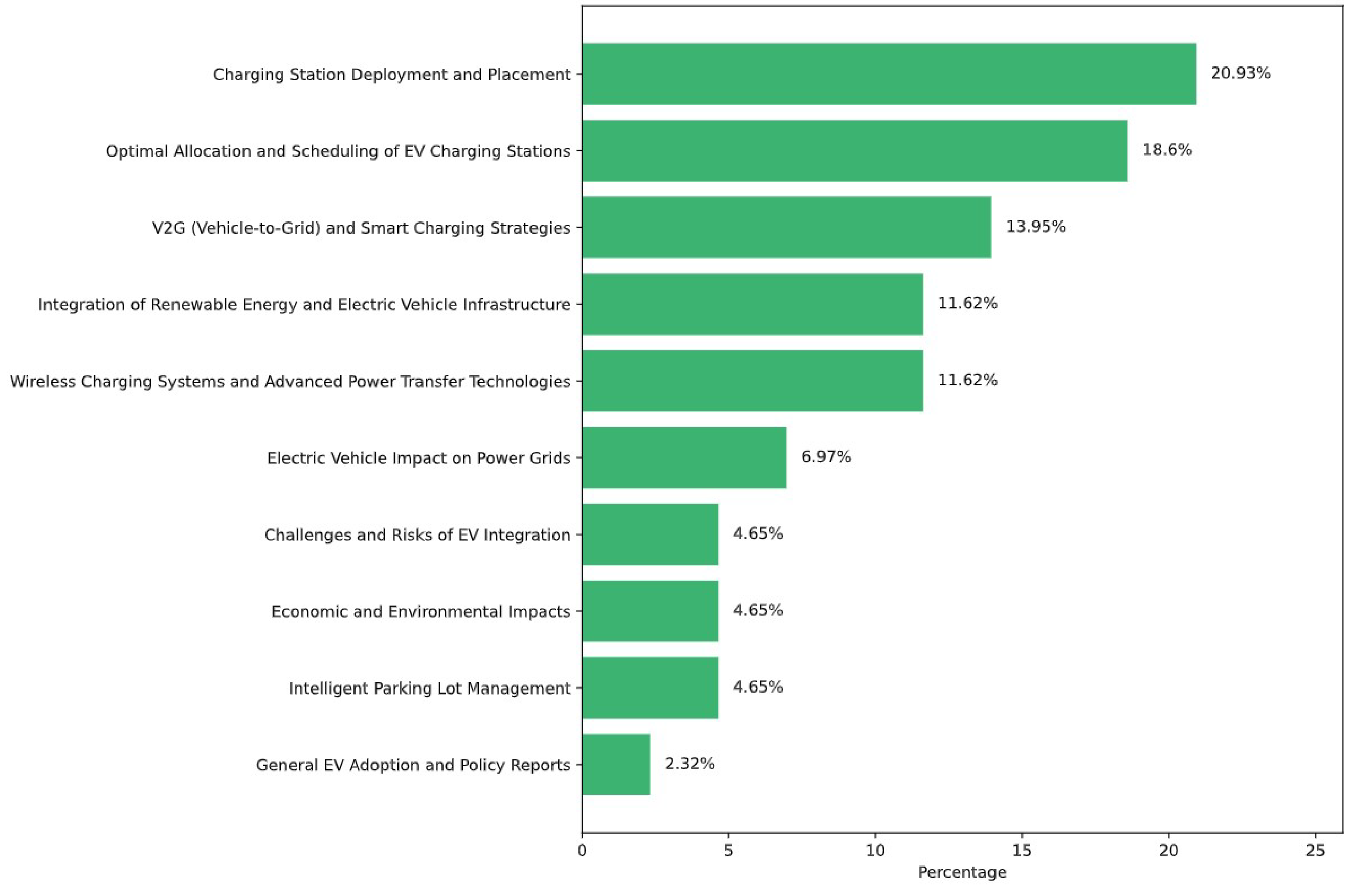
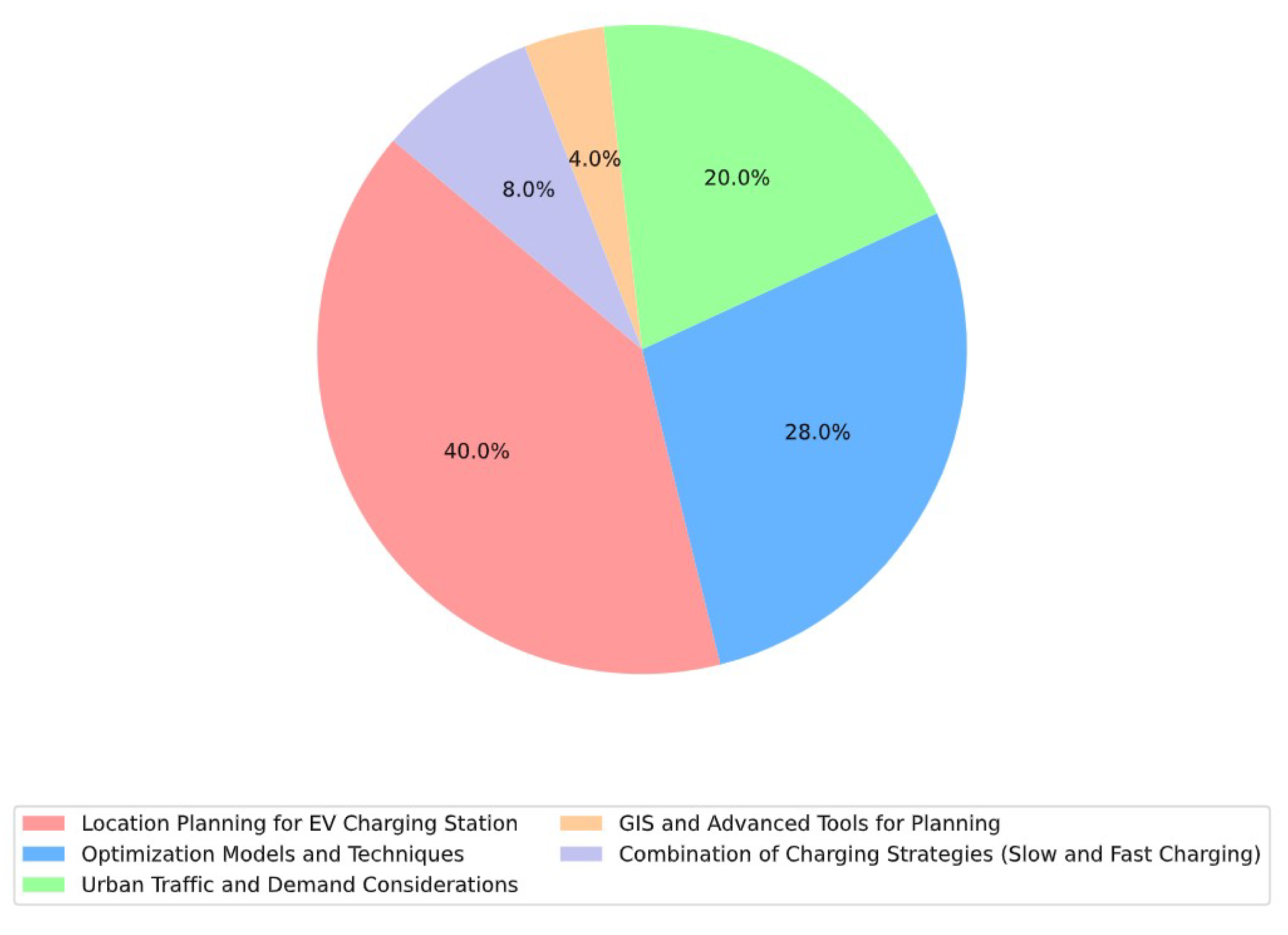
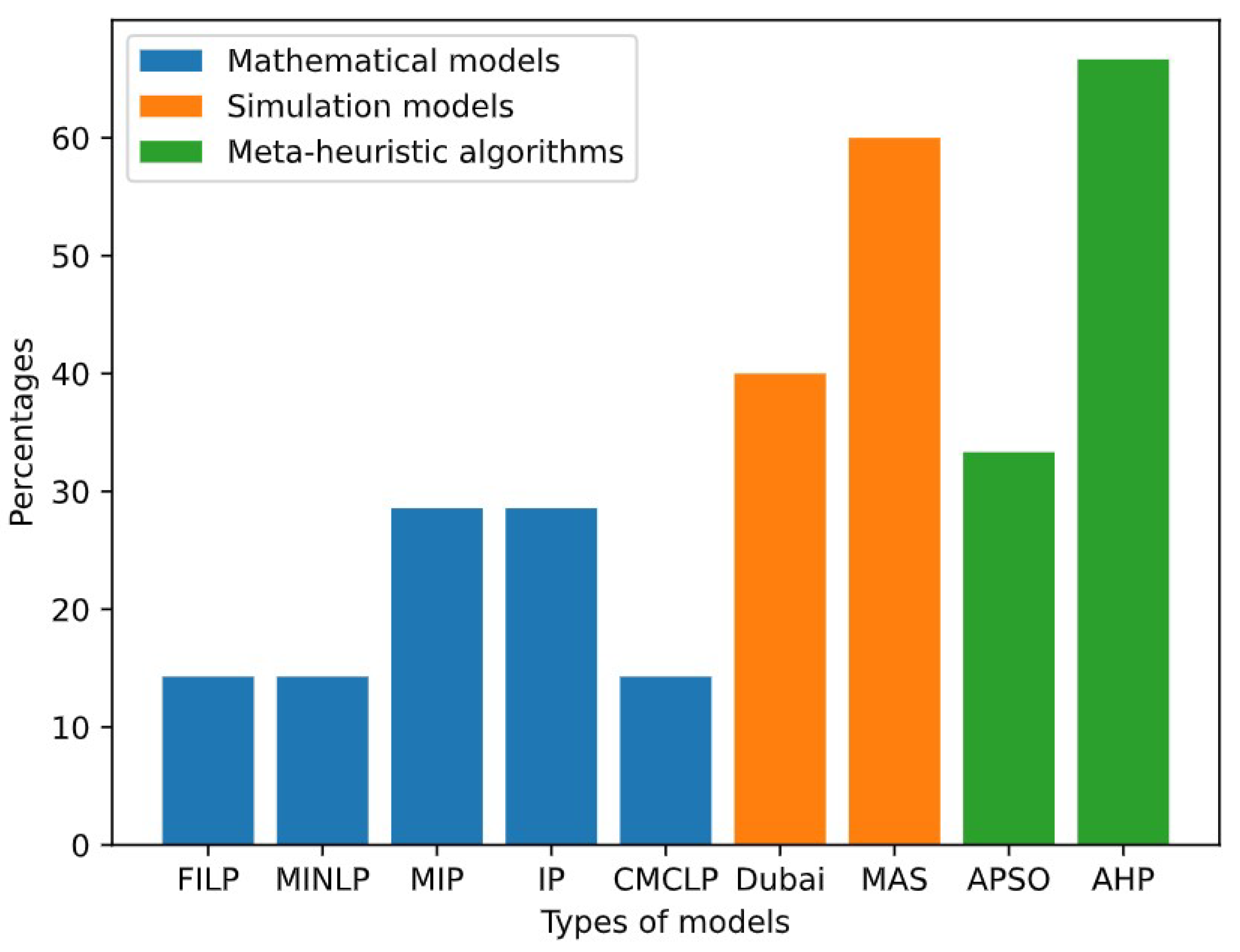
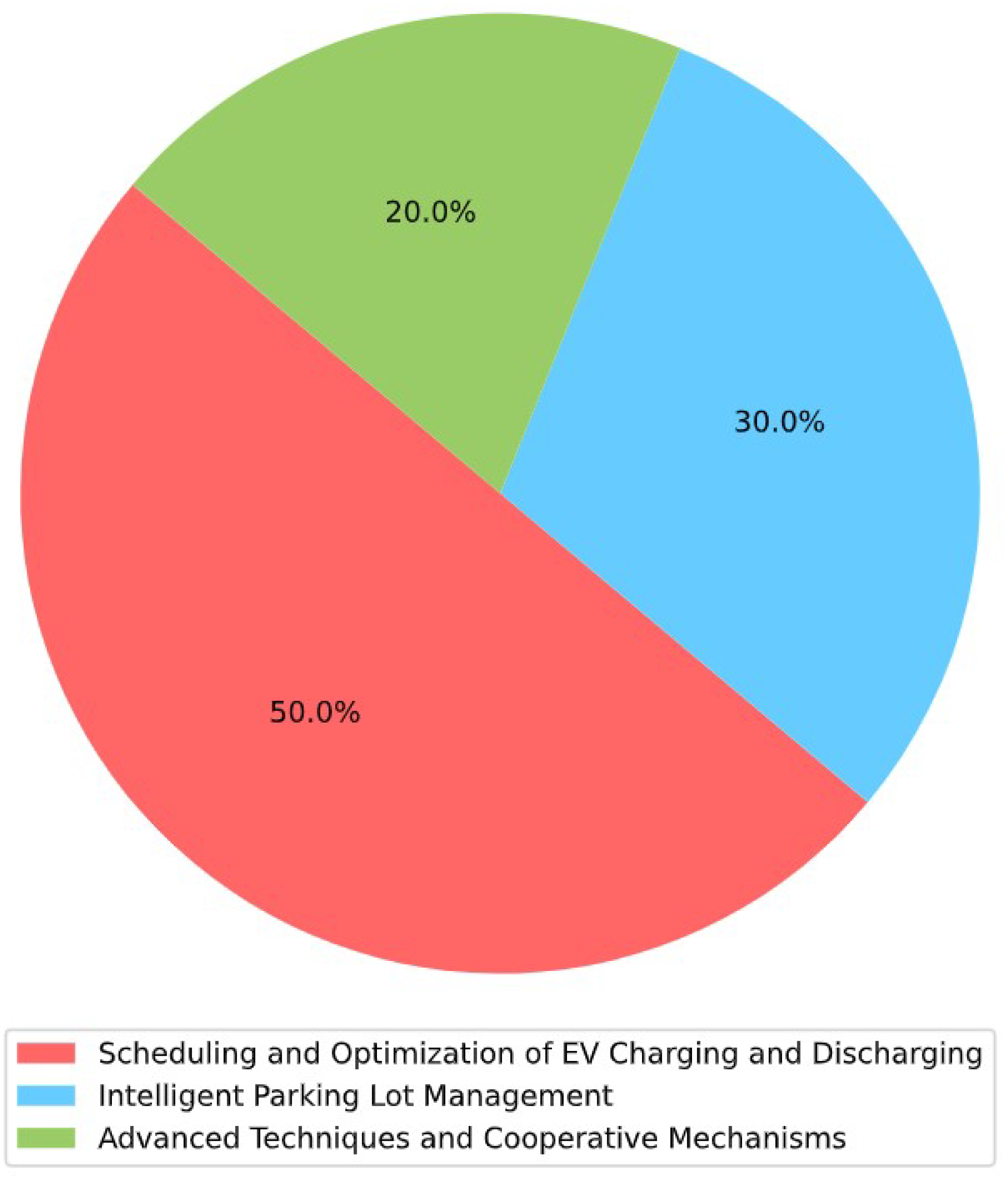
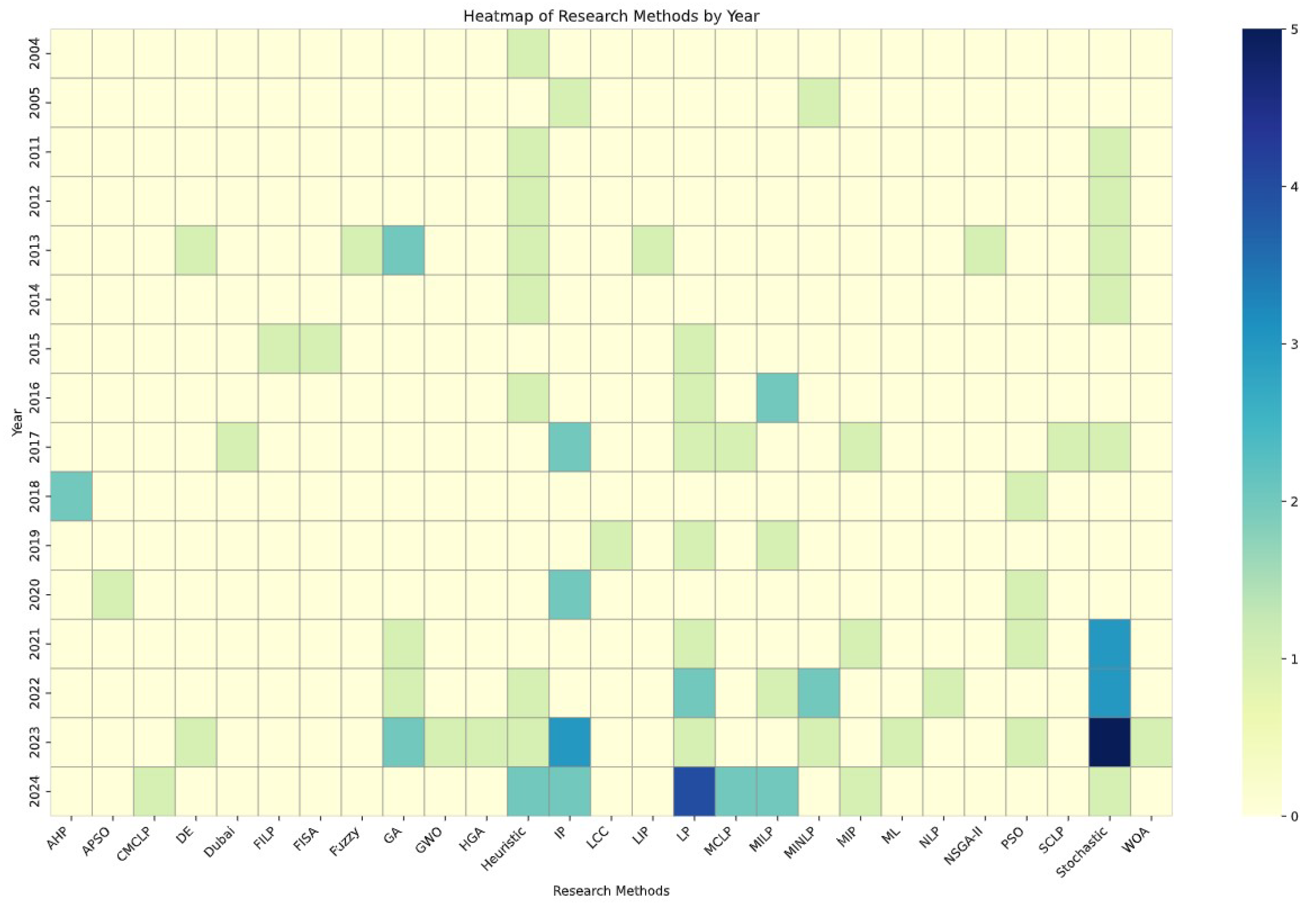
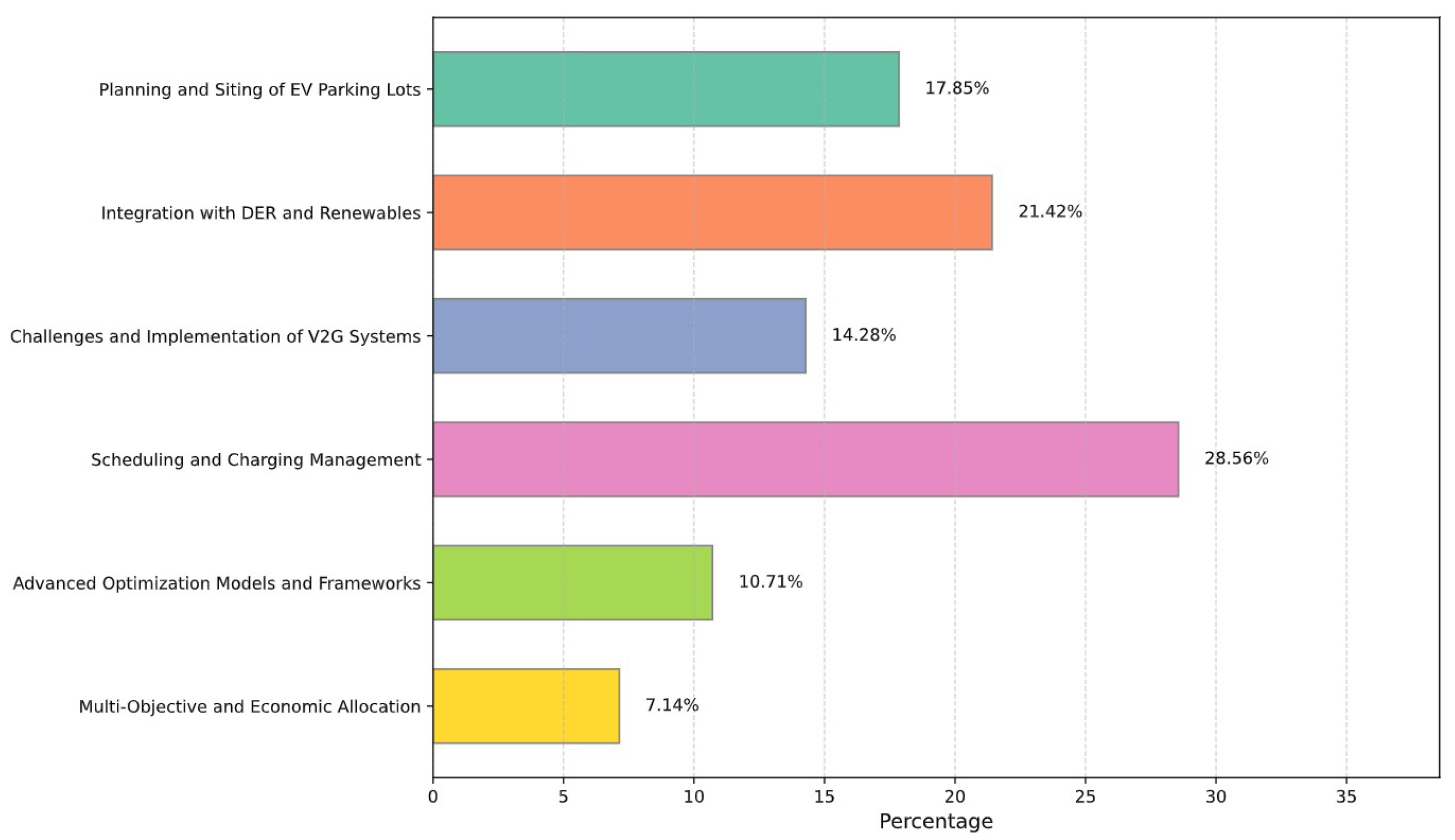
| Charging | Voltage | Current | Useful | Maximum | Charging | Connector |
|---|---|---|---|---|---|---|
| Level | Type | Type | Output | Time | Types | |
| Level 1 | 120 V | AC | 1.4 kW | 1.9 kW | 12 h | J1772 |
| Level 2 | 208–240 V | AC | 7.2 kW | 19.2 kW | 3 h | J1772 |
| Level 3 | 100–450 V | DC | 50 kW | 150 kW | 20 min | J1772/CHAdeMO/Supercharger |
| Model Type | Objective | Constraints | Suitable Scenarios | Strengths/Limitations |
|---|---|---|---|---|
| Linear Programming (LP) | Minimize cost | Resource limits, demand | Deterministic demand, urban areas | Simple, fast, but limited to linear relationships |
| Non-Linear Programming (NLP) | Minimize cost | Non-linear constraints, demand | Complex relationships, urban areas | Handles non-linear relationships but computationally intensive |
| Mixed-Integer Linear Programming (MILP) | Minimize cost | Binary decisions, resource limits | Urban areas, large-scale planning | Combines integer and linear programming but can be slow for large problems |
| Genetic Algorithm (GA) | Optimize multi-objective | Resource limits, demand | Complex, multi-objective scenarios | Flexible, handles non-linearities but may not find global optimum |
| Particle Swarm Optimization (PSO) | Optimize multi-objective | Resource limits, demand | Dynamic, uncertain environments | Fast convergence but can get stuck in local optima |
| Ref. | Model | Focus Area | Advantages | Limitations | Algorithm | Simulation | Implication | Application Notes | |
|---|---|---|---|---|---|---|---|---|---|
| Objective Function/Formula | Type | ||||||||
| [41] | – | Station location planning | Simple, fast computation | Limited real-world validation | Network Model of E-GPSR | Network Simulator 2 (NS-2) | Avoids routing through congested nodes | Suitable for small-scale urban networks with predictable demand | |
| [42] | FILP | User-centric scheduling | Captures user uncertainty; improves experience | Real-time implementation challenges | FISA | Java | Improves EV user charging experience | Applied in real time Java-based platforms | |
| [33] |
SCLP: MCLP: | Dubai strategic transportation model | EVCS equity–efficiency | Balances station coverage with demand equity | SCLP may underutilize low-demand stations | MCLP | – | Balances equity and efficiency in EV planning | Strategic deployment of city-wide charging stations |
| [54] | AHP | Station placement | Integrates expert judgment; scalable | NP-hard p-median problem | Iterative p-median + AHP | – | Optimizes EV station number and location | Used for determining station quantity and optimal distribution | |
| [32] | APSO | Holistic planning | Strong convergence speed; adaptive to system changes | Assumes fixed EV behavior | PSO | – | Holistic planning tool for EV infrastructure | Suitable for evolving grid environments | |
| [46] |
SCLP: | MINLP | V2G siting in microgrids | Accurate; captures battery wear and costs | High computational complexity | Two-stage heuristic | – | V2G reduces microgrid costs. | Tailored for microgrids with energy storage |
| [49] | MAS | Residential charging | Reflects household consumption patterns | Focuses on residential charging only | – | TEEMA | MAS models heterogeneous agents | Home-based, agent-specific scheduling | |
| [1] | MIP | Charging station layout optimization | Effective for integrated system coverage | Fixed path flows; no stochastic demand | Genetic Algorithm | – | Combines SRS, FRS, BES for better coverage. | Robust solution for defined grid layouts | |
| [50] | IP | Location optimization | Easy to compute; straightforward structure | Independent location simulation | – | – | Optimal locations remain under budget changes | General location planning under cost variation | |
| [43] | IP | Budget-constrained allocation | Maintains stable allocations under changing parameters | No partial allocation allowed | Stochastic programming | – | Stable decisions across budgets and congestion | Applicable for staged rollout of EVSE | |
| [51] | CMCLP | Intracity charging access | Coverage for short urban trips | Focuses on intracity trips only | ABM | MATSim | Generalizable for future EVSE planning | Urban-specific mobility and accessibility design | |
| [53] | MIP | Routing optimization | High-capacity modeling | No adaptive routing | HGA | – | Covers outbound and return trips | Applied to round-trip network problems | |
| Ref. | Model | Limitations | Algorithm | Implication | |
|---|---|---|---|---|---|
| Objective Function/Formula | Type | ||||
| [77] | MINLP | RES uncertainty is ignored; deterministic generation profiles are assumed. | HMA | The proposed method reduces total cost and technical losses compared to standalone GA. | |
| [21] | MILP | Relies on day-ahead forecasts; real-time adaptability is limited to hourly updates. | LP | ES helps mitigate mismatches between day-ahead forecasts and real-time demand, reducing penalties. | |
| [75] | MINLP | Assumes known arrival/departure times and energy needs; no stochastic modeling. | Support Vector Regression (SVR) using SVM | SVM-based forecasting improves scheduling accuracy (MAPE = 1.53%). | |
| [81] | MINLP | Focuses on transformer capacity but does not model voltage, phase imbalance, or cable limits. | MINOS (via NEOS server) | Prevents overload by scheduling discharging to support transformer capacity. | |
| [73] | MINLP | Focuses on transformer capacity but omits voltage, frequency, and phase balancing. | PSO, DE, WOA, GWO | WOA had the best convergence; PSO was fastest computationally. | |
| [78] | MILP | Charging behavior (SoC, budget) is predicted but treated as deterministic in optimization. | SVM, MLP | Incorporates user preferences (SoC, budget) into optimization. | |
| [76] | MOOP | Assumes fixed upstream/downstream prices; no bidding or ancillary services. | MOHESA | Balances aggregator profit with user satisfaction (SoC and cost). | |
| [79] | MILP | Focuses on energy balance; omits voltage, frequency, and line limits. | – | Combines stochastic and IGDT to handle different uncertainty types effectively. | |
| [80] | Fuzzy | Real-time strategy lacks global foresight; may miss optimal long-term schedules. | – | Strategy is computationally light and suitable for real-time deployment. | |
| Research Method | Deployment and Placement | Scheduling and Allocation | V2G and Smart Charging |
|---|---|---|---|
| MILP/MINLP/IP | ✓✓ | ✓ | ✓ |
| Heuristics (GA, PSO, WOA, etc.) | ✓✓ | ✓✓ | ✓ |
| Agent-Based Models (ABM) | ✓ | ✓✓ | ✓✓ |
| Simulation Models (e.g., TEEMA, Monte Carlo) | ✓ | ✓ | ✓✓ |
| AI and Machine Learning (LSTM, DRL, GNN) | ✓ | ✓✓ | ✓✓ |
| Multi-Criteria (AHP, Fuzzy, MCDM) | ✓✓ | ✓ | – |
| Hybrid Approaches (e.g., AI + MILP, GA + PSO) | ✓ | ✓ | ✓ |
Disclaimer/Publisher’s Note: The statements, opinions and data contained in all publications are solely those of the individual author(s) and contributor(s) and not of MDPI and/or the editor(s). MDPI and/or the editor(s) disclaim responsibility for any injury to people or property resulting from any ideas, methods, instructions or products referred to in the content. |
© 2025 by the authors. Published by MDPI on behalf of the World Electric Vehicle Association. Licensee MDPI, Basel, Switzerland. This article is an open access article distributed under the terms and conditions of the Creative Commons Attribution (CC BY) license (https://creativecommons.org/licenses/by/4.0/).
Share and Cite
Aarabi, M.S.; Khanahmadi, M.; Awasthi, A. A Literature Review on Strategic, Tactical, and Operational Perspectives in EV Charging Station Planning and Scheduling. World Electr. Veh. J. 2025, 16, 404. https://doi.org/10.3390/wevj16070404
Aarabi MS, Khanahmadi M, Awasthi A. A Literature Review on Strategic, Tactical, and Operational Perspectives in EV Charging Station Planning and Scheduling. World Electric Vehicle Journal. 2025; 16(7):404. https://doi.org/10.3390/wevj16070404
Chicago/Turabian StyleAarabi, Marzieh Sadat, Mohammad Khanahmadi, and Anjali Awasthi. 2025. "A Literature Review on Strategic, Tactical, and Operational Perspectives in EV Charging Station Planning and Scheduling" World Electric Vehicle Journal 16, no. 7: 404. https://doi.org/10.3390/wevj16070404
APA StyleAarabi, M. S., Khanahmadi, M., & Awasthi, A. (2025). A Literature Review on Strategic, Tactical, and Operational Perspectives in EV Charging Station Planning and Scheduling. World Electric Vehicle Journal, 16(7), 404. https://doi.org/10.3390/wevj16070404






